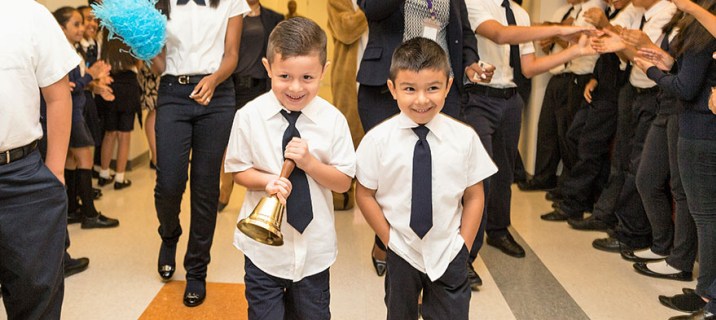If ever there were reason to rejoice over a standardized test, this is the time.
Let me explain. I oversee curriculum and assessment for the Uno Charter School Network (UCSN), which serves nearly 8,000 K-12 students in Chicago, primarily from Latino families. This year we are working closely with Chicago Public Schools (CPS) to offer our students the opportunity to earn the State Seal of Biliteracy in 12th grade. We’re also piloting a CPS Seal of Biliteracy for eligible fifth- and eighth-grade students.
This means that hundreds of our students will take a standardized test that will allow them to receive an academic accolade for the exact same skill and knowledge for which previous generations, perhaps even their parents, had been punished: speaking Spanish.
A BRIEF HISTORY
I grew up in a town with a large and vibrant Latino community, but precious few in my generation spoke Spanish. I had only a tiny vocabulary and didn’t attain fluency until I was an adult.
But this experience led me to understand two things: just how big of an advantage bilingualism is, and why so few in my (and previous) generation retained it.
The days when Spanish language proficiency was extinguished and penalized are not far behind us. The “English only” political movement of the ’80s and ’90s set in motion bold anti-bilingual actions affecting large swaths of the population.
The U.S. does not have an official language, but that has not stopped several states from designating English as their official language to prevent bilingualism in government offices and schools. Even now some fringe school leaders around the country not only prohibit bilingual instruction, but unlawfully ban Spanish from being spoken socially, in their halls and cafeterias. These actions have been found to be unconstitutional, yet the practice persists.
SPEAKING SPANISH IS NOT A SICKNESS
We in public education presently measure bilingualism in students as though it was a sickness. Our goal is to diagnose students and cure them of it.
When students come into our schools, and they indicate via home language surveys that they have a particular type of prior knowledge—we screen them. We determine the proper “dosage” of English-language services necessary to cure them of it. We test them periodically to see if our remedies have been effective.
It’s honestly not that different than previous generations of public educators who simply sought to extinguish the prior language entirely.
But in the rest of the developed world, proficiency in multiple languages is an asset. And by any objective measure this is true.
Just enter “bilingual candidates preferred” into a job search engine, and the search results are endless. Most sectors of the economy are working very hard to get their hands around the explosive growth of Latino and Spanish-speaking populations in the U.S., and they desperately need a multilingual workforce.
Bilingualism improves cognitive abilities both short- and long-term. Bilingual students perform better on math, literacy and reasoning assessments. Bilingual persons are looked upon favorably by competitive colleges and universities. Oh, and they earn more on average than their monolingual counterparts.
TREASURE WHAT YOU MEASURE
One way we devalue bilingualism is that historically we simply haven’t measured it. And we communicate to our school leaders that what matters most is what we measure.
Keep in mind, in many cases, prior knowledge is rewarded and valued in our schools, but not uniformly or with equity. Certain types of prior knowledge are considered assets while others are considered liabilities. Students whose parents have a sophisticated command of English carry that prior knowledge into the classroom, and are rewarded. But language proficiency associated with low-income or immigrant populations (particularly Spanish) are not only undervalued as prior knowledge but are stigmatized.
Piloting the CPS Seal of Biliteracy in fifth and eighth grades will ensure that bilingualism is measured, recognized and honored at multiple points in a student’s education. This will fundamentally change bilinguals’ educational experience.
I am proud of UCSN and CPS’ enthusiastic collaboration. Like work done by Californians Together, this effort in Chicago has required collaboration from all corners of the education sector, including CPS, charters, administrators and teachers.
Shedding light on our students’ bilingualism will finally acknowledge it for the asset it is. And better yet, I know our students will shine!
So this is one standardized test that we’ll be happy to give to our students, because we will be measuring something that we know matters.
This post originally appeared on Education Post.
Evan Gutierrez
He serves as Director of Curriculum and Assessment for UCSN (Uno Charter School Network) in Chicago where he lives with his wife April and their two children Silvio and Miriam.
Latest posts by Evan Gutierrez (see all)
- El Bilingüismo De Nuestros Estudiantes es Un Acierto, No Un Error - April 3, 2017
- Our Students’ Bilingualism Is an Asset, Not a Deficit - April 3, 2017

